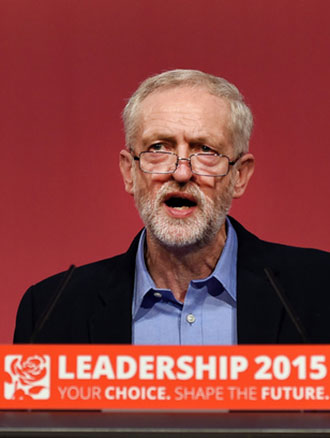September
Just how exceptional is Jeremy Corbyn's victory?

Dr Martin Farr compares the scale of Jeremy Corbyn's victory with those of earlier Labour Party leaders for The Conversation.
An earthquake isn’t any less of an earthquake for its being called such repeatedly. At least this one was predicted, eventually. Some indications as to just how seismic is the election of Jeremy Corbyn (pictured) as leader of the Labour Party really is may be found by measuring it against the party’s historical Richter scale.
For all the justified astonishment, Corbyn’s win isn’t uniquely remarkable. Slightly more than Tony Blair’s 57%, Corbyn’s 59.5% is a shadow of Neil Kinnock’s two wins: 71% over Roy Hattersley, Eric Heffer and Peter Shore in 1983, and 89% over Tony Benn in 1988. Kinnock’s successor John Smith achieved 91% in his 1992 contest with Bryan Gould, whose challenge was avowedly tokenistic (something it shared with Corbyn’s). The difference is that Kinnock and Smith were expected to win.
The political identity of the new Labour leader is genuinely historic. Depending on one’s political disposition, since its emergence as a party of government in 1924, Labour has been too sensible, or too timid, to elect a radical as leader. The frequently mis-cited Michael Foot had been a conspicuously loyal cabinet minister for five years (in contrast to Benn, Corbyn’s mentor). Even George Lansbury (1932-5), the predecessor with whom Corbyn has most in common, was a national figure who’d held ministerial office.
Not just his turn
Corbyn’s victory reverses a generational shift. As perhaps befits a house of legislators often accused of acting like children, intakes of MPs are often referred to as “classes”. Labour’s class of 1945 produced four leaders (Hugh Gaitskell 1955-63, Harold Wilson 1963-76, James Callaghan 1976-80, Michael Foot 1980-3), and 1970 two (Neil Kinnock 1983-92, John Smith 1992-4). We might have thought that the classmates of 1983 had long since graduated to long trousers, after Gordon Brown followed Tony Blair out of office and parliament – but it turns out there remained one refusenik.
No major party has ever had a permanent leader who hadn’t planned to be leader (or possibly even want to be). Modest in all matters, Corbyn meant it when he said he’d not expected to win, and that it was merely “my turn” to follow Diane Abbott (2010), John Prescott (1994), Gould, Benn, and Heffer and offer the party a clear alternative to candidates of the “right” or “centre”. The climate of politics in 2015 – internationally as well as nationally – has proven to be more propitious than it was for the earlier campaigns, and Corbyn is the beneficiary.
As with Kinnock, Corbyn spent years refusing to serve on the front bench, but only one Labour leader has had as much ministerial experience as Corbyn (that is, none): Blair. And when Blair became leader in 1994, Labour had been out of office for so long that few MPs had any ministerial experience at all. In 2015 it was Andy Burnham and Yvette Cooper’s ministerial experience that turned many against them.
Defenestrated and demonised
Whereas Conservative MPs have seldom baulked at ridding themselves of leaders who proved to be liabilities, Labour’s more collectivist political culture meant it was averse to defenestration. Labour leaders have unwillingly relinquished office only through death, and indeed, the only party leaders to have died in the last century were Labour ones: (Gaitskell in 1963, Smith in 1994).
Demonisation is another matter. From Ramsay MacDonald (1922-32; “Having been born a socialist, he died a bloody Tory”) to “Bliar” himself, Labour prime ministers are usually regarded as having let the movement down. (The effect of Blair’s three public warnings against electing Corbyn is testament to his standing with members.)
The scale of Corbyn’s victory means that he cannot be thought of – as Blair was, not least by Corbyn himself – as something grafted onto the party, and susceptible to antibodies. Instead, Corbyn’s near-60% vote share has shattered the most plausible case for an internal challenge on grounds of legality or morality: there weren’t anything like enough #toriesforcorbyn to have swung the result.
Bigger than ever
Labour is, as its new leader has said, bigger than it’s been “for a very, very long time”, in large part due to him. There are now around 325,000 members, more than the Conservative and Liberal Democrat parties put together, and more than Labour has had since 1999, when Blair was still an asset. (Curiously there were still 131,608 people eligible to vote who chose not to.)
Some things haven’t changed. On February 12 1906 Keir Hardie’s election as Labour’s first leader was declared. On September 12 2015, a special conference announced that Corbyn and Tom Watson were leader and deputy leader. At each event, the only people who spoke in an official capacity were men. At least in 1906, women weren’t allowed to participate in parliamentary affairs – much to Hardie’s disgust – but 97 years after (limited) female suffrage, and 22 years after Labour itself introduced all-women shortlists, anyone following the results event on radio would be forgiven for thinking that no woman was present (none are now in the five most senior positions in the Parliamentary Labour Party).
2015 can now be added to 1918, 1945, and 1979 as one of the most significant years in British politics in the last hundred years. Corbyn immediately promised that things will change. Much already has, and more may yet with the inevitable aftershocks. And if 2020 sees Corbyn as prime minister being greeted in the White House Rose Garden by President Trump – or, as Corbyn might prefer, President Sanders – not entirely dissimilar transatlantic currents will have brought them together.
Martin Farr is Senior Lecturer in Modern and Contemporary British History.
published on: 14 September 2015
